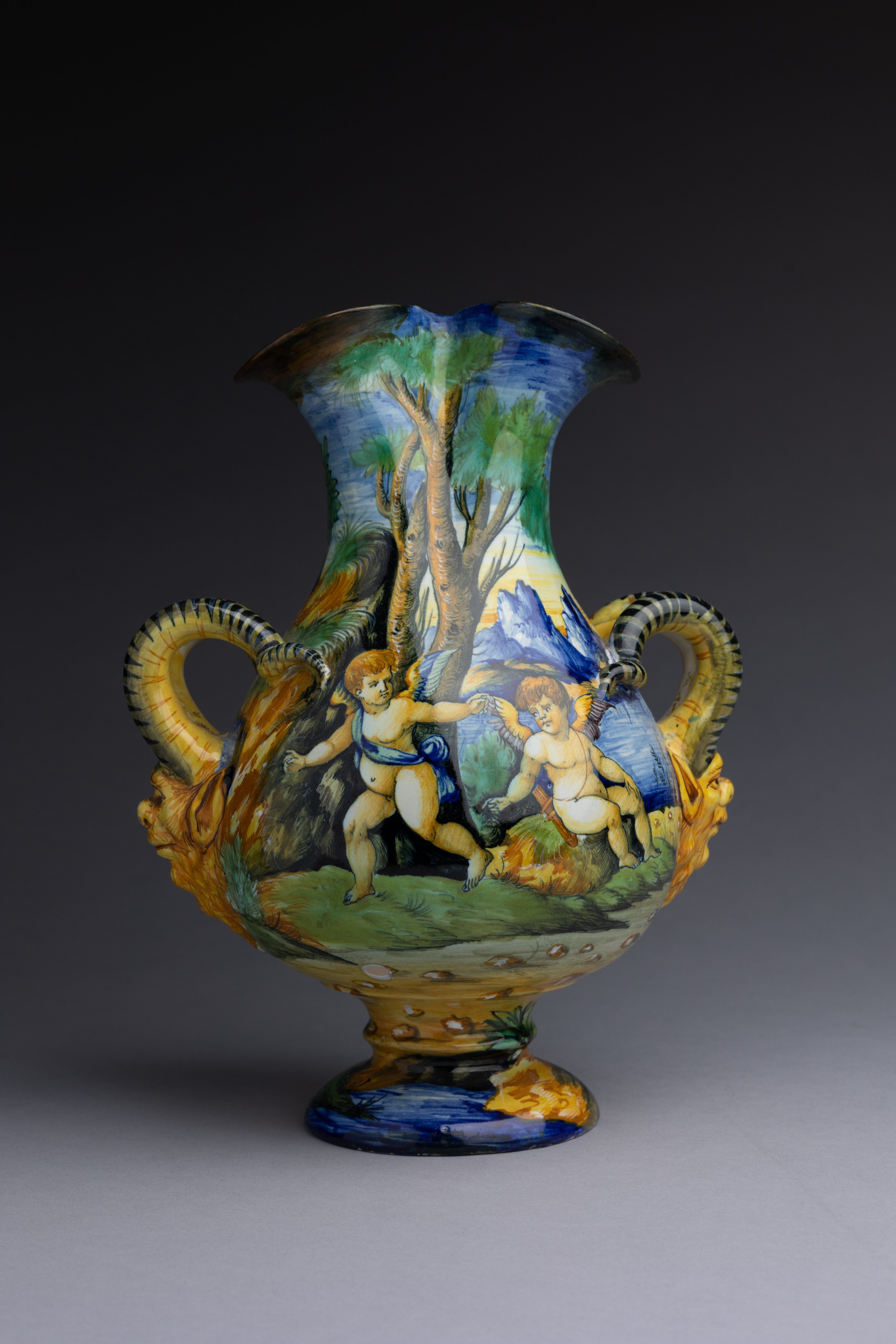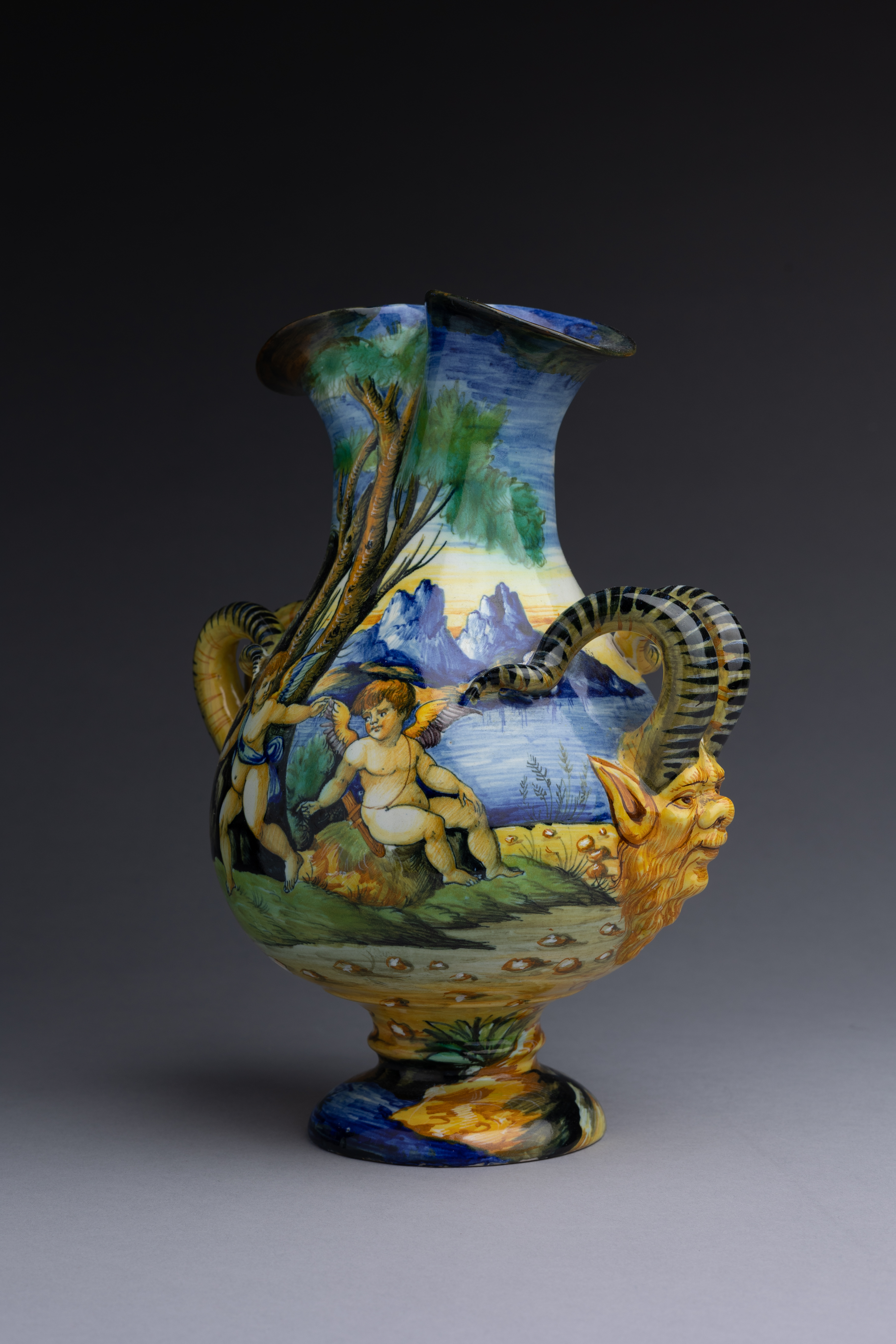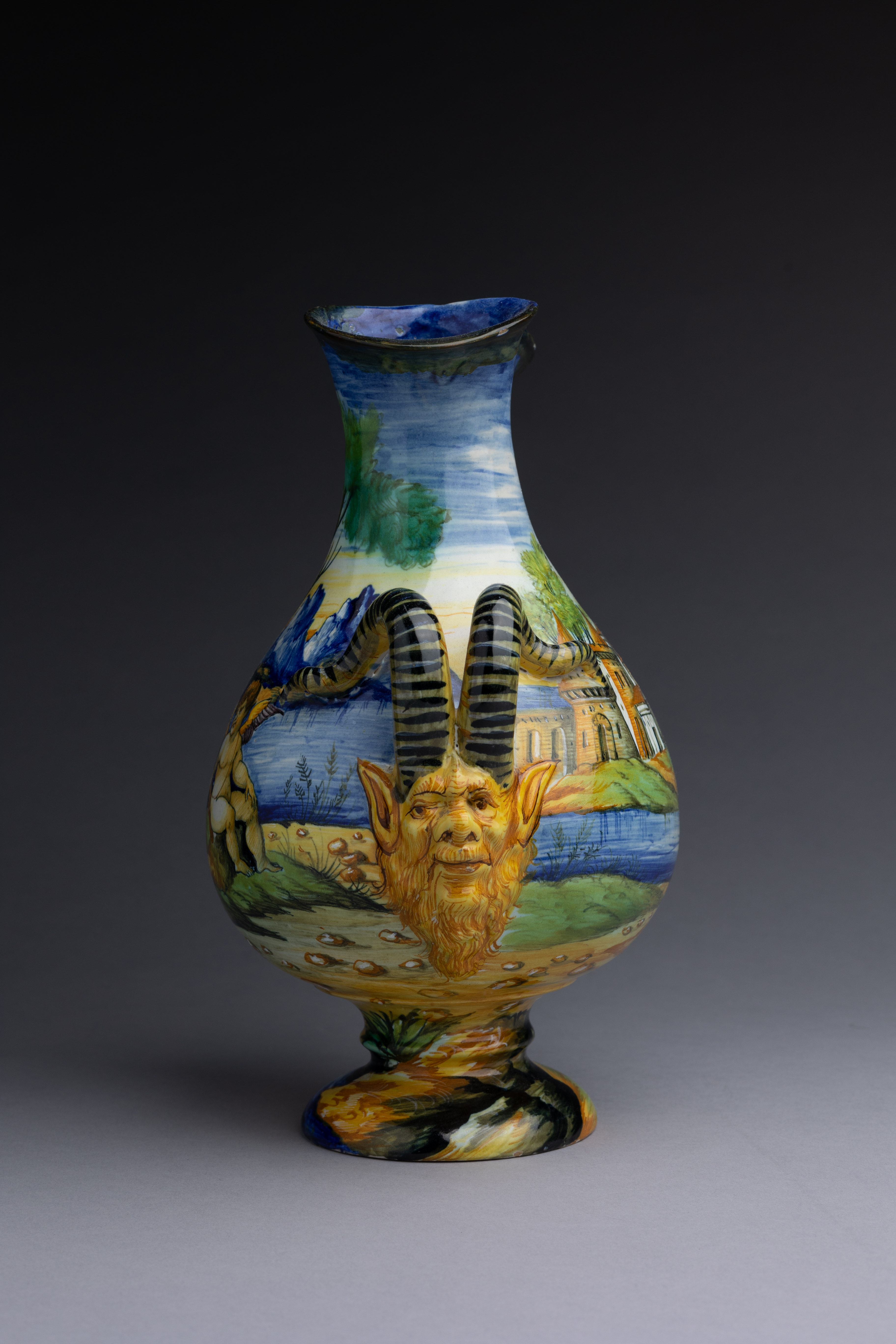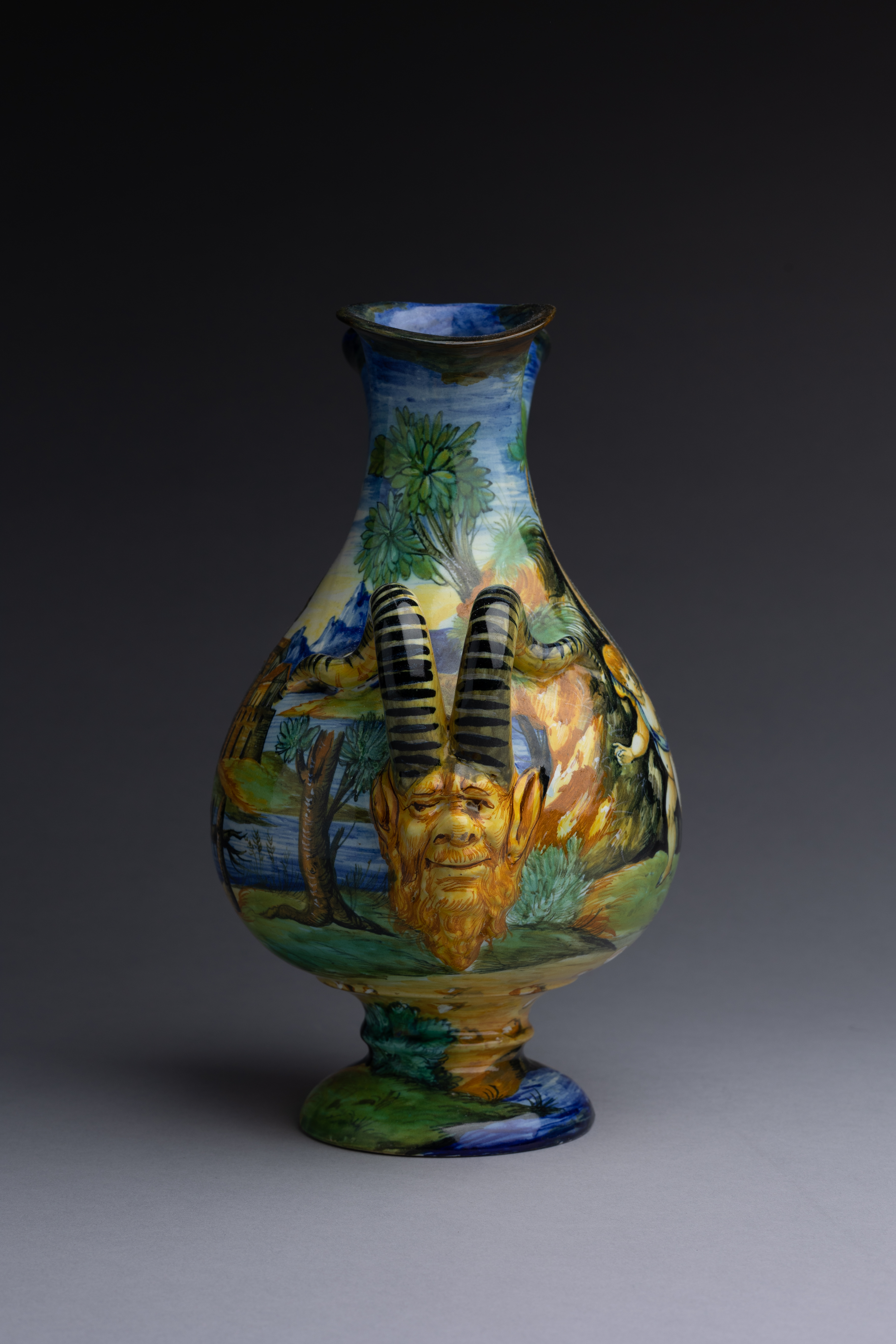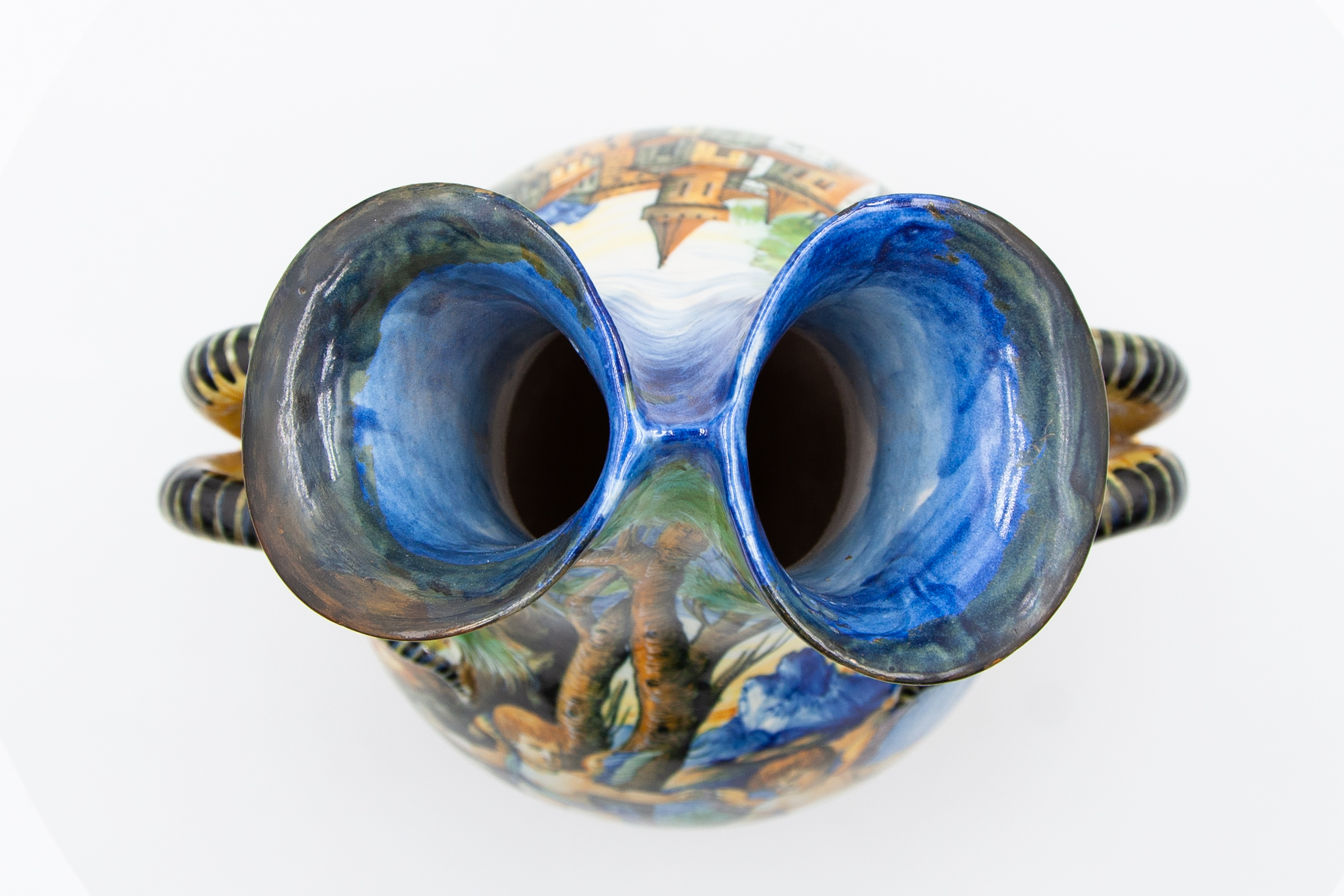Harkening back to the Italian Renaissance, Cantagalli’s styles, designs, and motifs are inspired by Renaissance ceramics, such as those of Guido Durantino made in Urbino in the 16th century. The vase depicts two putti on a riverside architectural backdrop with a color palette meticulously precise in its allusion to ceramics from centuries before.
Harkening back to the Italian Renaissance, Cantagalli’s styles, designs, and motifs are inspired by Renaissance ceramics, such as those of Guido Durantino made in Urbino in the 16th century. The vase depicts two putti on a riverside architectural backdrop with a color palette meticulously precise in its allusion to ceramics from centuries before.
Essay
During the 19th century, Europe experienced a second renaissance, that is, a revival of the Renaissance itself. For a long time it was contended that the ‘historicist’ styles of the 19th century were empty imitations of the 15th, 16th, and 17th century historical forms that inspired them. However, today “revival style” ceramics are seen as an important historical phenomenon in itself instead of as late “fakes”.
In 1878, Ulisse Cantaglli converted his father’s brick factory to produce ceramic satisfying the contemporary interest in maiolica, one of the most illustrious artforms in Europe during the Renaissance, and began marking them with a blue cockerel – a pun on the Cantagalli name. By doing so, Cantagalli aligned himself with other European “revivalists’ such as Theodore Deck and his Chinese-based ceramics in France and the Minton Manufactury’s Gothic Revival wares in England spearheaded by Pugin. But Cantagalli’s revival of Italian Renaissance maiolica was much more than a coincidental appeal to contemporary taste. Many historical changes that took place in Italy were a driving force behind these types of ceramics.
Up until the 19th century, the Italian peninsula was a land separated by different dialects, regional feuds, and foreign governance. In a process taking place largely between 1848 and 1918, the unification of Italy to one independent “Kingdom of Italy,” also known as the Risorgimento, consolidated together the different Italian states. It was then that the Italian nation began to look back again to its history in order to develop a greater future.
Revival ceramics served an important role in this endeavour. They aided in the deployment of a shared national history and a common language upon which a united nation could emerge. These ceramics did not only provide an ability to communicate across the new country’s large disparate regions, but also an opportunity to acquire and take part in the greater spirit of Italian independence and grandeur. In a return to a former glory, Italians systematically looked back to the ages that created the Italian ethos and made it a great nation: Ancient Rome and Renaissance Italy.
The archival zealousness that was coupled with these political dimensions resulted in the excavation and resurface of a lost history, and the innovations of the Industrial Revolution allowed for these wares to be produced and distributed on a large scale. Yet, the process of manufacture remained much the same as it was during the Renaissance: hand-painted and hand-formed ceramics, based on significant historical designs.
Cantagalli was inspired by 16th-century maiolica originating in Urbino, some of which were signed by the great ceramic artists of the time, including Nicola da Urbino and Francesco Xanto Avelli, and Guido Durantino. Cantagalli reproduced the color palettes, styles, and techniques that made these wares among the most expensive and sought after works of art throughout the 16th century. Much like the patisches created by Renaissance ceramics artists who drew on various sources, including paintings, frescos, and prints, so did Cantagalli incorporate old designs in new shapes.
The grotesque figures on the bases of the handles harken to the Classical Roman fresco designs at the Domus Aurea, the unfinished Palace of Nero. Cantagalli’s use of historical forms was very much aligned with his Renaissance predecessors who sought to imitate the forms of the Roman Empire. The palace, excavated in Rome in the 16th century, became an immediate source of inspiration to Renaissance artists such as Orazio Fontana, one of the most renowned Italian renaissance ceramicists. The relief grotesques aided in linking their art, and themselves, to a grand Roman past, a sensibility we find on display in Cantagalli ceramics as well.
Cantagalli’s maiolica don’t just represent a reprise of old forms, or a nostalgic reminder of times past. The use of the Italian Renaissance in the production of new ceramic wares in Italy was intrinsically connected to a moment in the history of Europe that carried no less weight than that of any period before it. In describing these wares as “suitable for all types of interiors,” Cantagalli imagined that the language of Italian Renaissance art could be transported into the present and evoke a new idea of the future.
MA
Condition
Excellent. There are a few small areas where the glaze separated from the earthenware body during the original firing, most notably on the interior rim and under the putti scene.
For a detailed condition report, please contact us.
References
Ballay, Ute. “19th-Century Italian Majolica.” Antiques & Collecting Magazine 9 (1996): 38-44.
Damiani, Giovanna. “Fascinating Fantasies and the Search for Reality: Notes on Orientalism in Florence 1700-1800.” In From the Medicis to the Savoias: Ottoman Splendour in Florentine Collections, edited by Scalini, Mario, Giovanna Damiani, Nazan Ölçer, and David Alexander, 44-71. Sabancı Üniversitesi, Sakıp Sabancı Müzesi, 2003.
Del Pellegrino, Walter and Karen. Italian Pottery Marks from Cantagalli to Fornasetti (and Everyone in Between), 1850-1950. 2005.
Frescobaldi Malenchini, Livia, and Oliva Rucellai, eds. Il risorgimento della maiolica italiana: Ginori e Cantagalli (The revival of Italian maiolica). Firenze: Polistampa, 2011.
Hess, Catherine. Italian maiolica: catalogue of the collections. California: J. Paul Getty Museum, 1988.
Cited Works
During the 19th century, Europe experienced a second renaissance, that is, a revival of the Renaissance itself. For a long time it was contended that the ‘historicist’ styles of the 19th century were empty imitations of the 15th, 16th, and 17th century historical forms that inspired them. However, today “revival style” ceramics are seen as an important historical phenomenon in itself instead of as late “fakes”.
In 1878, Ulisse Cantaglli converted his father’s brick factory to produce ceramic satisfying the contemporary interest in maiolica, one of the most illustrious artforms in Europe during the Renaissance, and began marking them with a blue cockerel – a pun on the Cantagalli name. By doing so, Cantagalli aligned himself with other European “revivalists’ such as Theodore Deck and his Chinese-based ceramics in France and the Minton Manufactury’s Gothic Revival wares in England spearheaded by Pugin. But Cantagalli’s revival of Italian Renaissance maiolica was much more than a coincidental appeal to contemporary taste. Many historical changes that took place in Italy were a driving force behind these types of ceramics.
Up until the 19th century, the Italian peninsula was a land separated by different dialects, regional feuds, and foreign governance. In a process taking place largely between 1848 and 1918, the unification of Italy to one independent “Kingdom of Italy,” also known as the Risorgimento, consolidated together the different Italian states. It was then that the Italian nation began to look back again to its history in order to develop a greater future.
Revival ceramics served an important role in this endeavour. They aided in the deployment of a shared national history and a common language upon which a united nation could emerge. These ceramics did not only provide an ability to communicate across the new country’s large disparate regions, but also an opportunity to acquire and take part in the greater spirit of Italian independence and grandeur. In a return to a former glory, Italians systematically looked back to the ages that created the Italian ethos and made it a great nation: Ancient Rome and Renaissance Italy.
The archival zealousness that was coupled with these political dimensions resulted in the excavation and resurface of a lost history, and the innovations of the Industrial Revolution allowed for these wares to be produced and distributed on a large scale. Yet, the process of manufacture remained much the same as it was during the Renaissance: hand-painted and hand-formed ceramics, based on significant historical designs.
Cantagalli was inspired by 16th-century maiolica originating in Urbino, some of which were signed by the great ceramic artists of the time, including Nicola da Urbino and Francesco Xanto Avelli, and Guido Durantino. Cantagalli reproduced the color palettes, styles, and techniques that made these wares among the most expensive and sought after works of art throughout the 16th century. Much like the patisches created by Renaissance ceramics artists who drew on various sources, including paintings, frescos, and prints, so did Cantagalli incorporate old designs in new shapes.
The grotesque figures on the bases of the handles harken to the Classical Roman fresco designs at the Domus Aurea, the unfinished Palace of Nero. Cantagalli’s use of historical forms was very much aligned with his Renaissance predecessors who sought to imitate the forms of the Roman Empire. The palace, excavated in Rome in the 16th century, became an immediate source of inspiration to Renaissance artists such as Orazio Fontana, one of the most renowned Italian renaissance ceramicists. The relief grotesques aided in linking their art, and themselves, to a grand Roman past, a sensibility we find on display in Cantagalli ceramics as well.
Cantagalli’s maiolica don’t just represent a reprise of old forms, or a nostalgic reminder of times past. The use of the Italian Renaissance in the production of new ceramic wares in Italy was intrinsically connected to a moment in the history of Europe that carried no less weight than that of any period before it. In describing these wares as “suitable for all types of interiors,” Cantagalli imagined that the language of Italian Renaissance art could be transported into the present and evoke a new idea of the future.
MA
Excellent. There are a few small areas where the glaze separated from the earthenware body during the original firing, most notably on the interior rim and under the putti scene.
For a detailed condition report, please contact us.
Ballay, Ute. “19th-Century Italian Majolica.” Antiques & Collecting Magazine 9 (1996): 38-44.
Damiani, Giovanna. “Fascinating Fantasies and the Search for Reality: Notes on Orientalism in Florence 1700-1800.” In From the Medicis to the Savoias: Ottoman Splendour in Florentine Collections, edited by Scalini, Mario, Giovanna Damiani, Nazan Ölçer, and David Alexander, 44-71. Sabancı Üniversitesi, Sakıp Sabancı Müzesi, 2003.
Del Pellegrino, Walter and Karen. Italian Pottery Marks from Cantagalli to Fornasetti (and Everyone in Between), 1850-1950. 2005.
Frescobaldi Malenchini, Livia, and Oliva Rucellai, eds. Il risorgimento della maiolica italiana: Ginori e Cantagalli (The revival of Italian maiolica). Firenze: Polistampa, 2011.
Hess, Catherine. Italian maiolica: catalogue of the collections. California: J. Paul Getty Museum, 1988.
This item ships free to the continental US, and globally for a flat-rate fee of $100.
All objects are packed with utmost care by our team of expert fine art shippers. All items are shipped with parcel insurance.
For more information on our shipping policies, please visit our FAQ Page.

